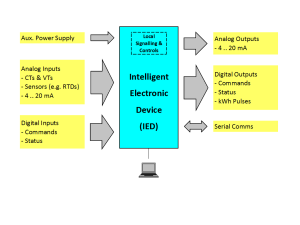Intelligent Electronic Device (IED)
IEDs receive data from sensors and power equipment and can issue control commands, such as tripping circuit breakers if they sense voltage, current, or frequency anomalies, or raise/lower voltage levels in order to maintain the desired level. Common types of IEDs include protective relaying devices, On Load Tap Changer controllers, circuit breaker controllers, capacitor bank switches, recloser controllers, voltage regulators etc. This is generally controlled by a setting file. The testing of setting files is typically one of the most time consuming roles of a protection tester.
Digital protective relays are primarily IEDs, using a microprocessor to perform several protective, control and similar functions. A typical IED can contain around 5-12 protection functions, 5-8 control functions controlling separate devices, an autoreclose function, self monitoring function, communication functions etc. Hence, they are aptly named as Intelligent Electronic Devices.
Some recent IEDs are designed to support the IEC61850 standard for substation automation, which provides interoperability and advanced communications capabilities.
Microprocessor-based voltage regulators, protection relays, circuit breaker controllers, etc. with the capability of serial communication with other devices are Intelligent Electronic Device (IEDs). This post contains a brief overview of IED electrical interfacing, functionality, HMI and setting studies.
Electrical interfacing
The diagram below contains all possible electrical interfacing of an Intelligent Electronic Device (IED).
Auxiliary power supply: Older protection relays and voltage regulators may not need auxiliary supply, but IEDs always require an auxiliary power supply. Most IEDs accept an extended range, e.g. 24 – 250 V DC /110 – 240 V AC.
Analog inputs: Protection relays and voltage regulators are always provided with current and voltage transformer inputs. Besides that, devices may be provided with sensor inputs (e.g. temperature sensors) and/or 4..20 mA inputs. Note that for some IEDs rated secondary current (1 A or 5 A) and frequency (50 or 60 Hz) must be specified before ordering. Note also that the correct phase of the sensing voltages and currents, and the right direction of the currents are important.
Digital inputs: Some IEDs require potential-free contacts for digital (logic) inputs, while others recognize the positive power supply voltage (source) or negative power supply voltage (sink) as a logical 1. Digital inputs may be commands or as status information.
Analog outputs: Some IEDs are provided with transducer outputs, e.g. 4..20 mA or 0..10 V. Mostly these outputs are programmable. These outputs can be active type or passive type outputs. The passive type requires external power supply.
Digital outputs: Digital outputs can be potential free normally open, normally close or change-over contacts or solid state contacts. It is important to check switching capability of the output contacts, because differences can be significant. Digital outputs may be commands or status information.
Serial communication ports: There are several ports possible for serial communication like RS 485, ethernet (RJ45), optical, etc.. IEDs are mostly also provided with an RS 232 or USB port for local communication with a laptop or PC.
Functionality
The extended functionality of an IED can be separated into the following groups: protection, control, monitoring, metering and communication.
Protection: This functionality covers all protection functions to protect a generator, motor, transformer or feeder.
Control functions and logics: These elements may be control loops in voltage regulators, control logics in circuit breakers, etc.
Monitoring: Each IED should have internal self-supervision and aux. supply monitoring. A “watch-dog” or “healthy” output contact will close if the IED is operating well. Monitoring may also include loss of analog sensing inputs (e.g. loss of voltage, current, temperature sensors), trip circuit supervision, event recording, etc.
Metering: Most IEDs contain metering values including line voltages (V), phase currents (A) and voltages (V), neutral current (A), residual voltage (V), frequency (Hz), power (MW, MVAr, MVA) and energy (kWh, KVArh), harmonics, disturbance recording, temperaturs and analog channels. Some IEDs are also provided with programmable transducer outputs.
Serial communication: IEDs could support protocols like Modbus RTU, Modbus TCP, Profibus, etc.. In order to enable interoperation of IEDs from different vendors, IEC created the modern IEC 61850 standard.



